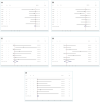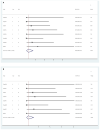Willis covered stent treatment for blood blister-like aneurysm: A meta-analysis of efficacy and safety
- PMID: 36895627
- PMCID: PMC9990463
- DOI: 10.3389/fneur.2022.1101625
Willis covered stent treatment for blood blister-like aneurysm: A meta-analysis of efficacy and safety
Abstract
Background: Blood blister-like aneurysm (BBA) is a rare and special type of intracranial aneurysm with extremely high rates of rupture, morbidity, mortality, and recurrence. Willis Covered Stent (WCS) is a new device that is specifically designed for the treatment of intracranial complex aneurysms. However, the efficacy and safety of WCS treatment for BBA remain controversial. Thus, a high level of evidence is required to prove the efficacy and safety of WCS treatment.
Methods: A systematic literature review was performed using a comprehensive literary search in Medline, Embase, and Web of Science databases to identify studies related to WCS treatment for BBA. A meta-analysis was then conducted to incorporate the efficacy and safety outcomes, including intraoperative situation, post-operative situation, and follow-up data.
Results: Eight non-comparative studies containing 104 patients with 106 BBAs met the inclusion criteria. In the intraoperative situation, the technical success rate was 99.5% [95% confidence interval (CI), 0.958, 1.000], the complete occlusion rate was 98.2% (95% CI, 0.925, 1.000), and the side branch occlusion rate was 4.1% (95% CI, 0.001, 0.114). Vasospasm and dissection occurred in 9.2% (95% CI, 0.000, 0.261) and 0.1% (95% CI, 0.000, 0.032) of the patients, respectively. In the post-operative situation, the rebleed and mortality rates were 2.2% (95% CI, 0.000, 0.074) and 1.5% (95% CI, 0.000, 0.062), respectively. In the follow-up data, recurrence and parent artery stenosis occurred in 0.3% (95% CI, 0.000, 0.042) and 9.1% (95% CI, 0.032, 0.168) of the patients, respectively. Ultimately, 95.7% (95% CI, 0.889, 0.997) of the patients had a good outcome.
Conclusions: Willis Covered Stent could be effectively and safely applied for BBA treatment. The results provide a reference for clinical trials in the future. Well-designed prospective cohort studies must be conducted for verification.
Keywords: blood blister-like aneurysm; covered stent; efficacy; meta-analysis; safety.
Copyright © 2023 Tan, Song, Luo, Fu, Su and He.
Conflict of interest statement
The reviewer [OC] declared a shared affiliation with the authors to the handling editor at the time of review. The authors declare that the research was conducted in the absence of any commercial or financial relationships that could be construed as a potential conflict of interest.
Figures




References
-
- Shah SS, Gersey ZC, Nuh M, Ghonim HT, Elhammady MS, Peterson EC. Microsurgical versus endovascular interventions for blood-blister aneurysms of the internal carotid artery: systematic review of literature and meta-analysis on safety and efficacy. J Neurosurg. (2017) 127:1361–73. 10.3171/2016.9.JNS161526 - DOI - PubMed
Publication types
LinkOut - more resources
Full Text Sources
Miscellaneous

